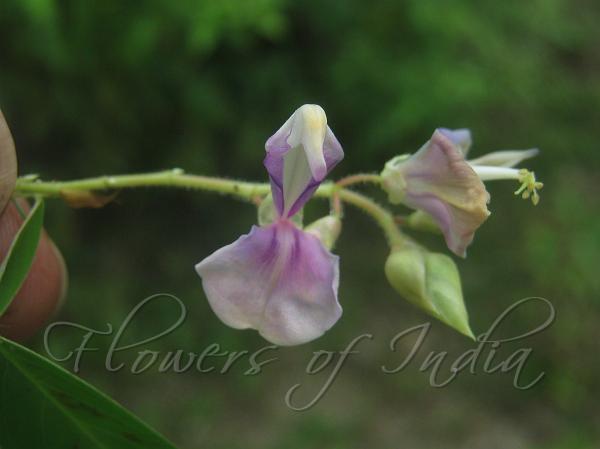|
| Telegraph Plant |
|

|

| File size | 254689 |
| Original date | 9/7/11 12:24 PM |
| Resolution | 2048 x 1536 |
| Flash | Flash did not fire, auto |
| Focal length | 6.6mm |
| Exposure time | 1/500s |
| Aperture | 3.0 |
| Focus Distance | |
| Metering Mode | Multi-segment |
| Camera make | Canon |
| Camera model | Canon PowerShot A495 |
| Sensor type | OneChipColorArea |
|
|
|
|
Photo: |
Botanical name: Codariocalyx motorius Family: Fabaceae (Pea family)
Synonyms: Hedysarum motorium, Desmodium gyrans, Hedysarum gyrans
Synonyms: Hedysarum motorium, Desmodium gyrans, Hedysarum gyrans
Telegraph Plant is famous for its movement of small lateral leaflets
at speeds rapid enough to be perceivable with the naked eye. This is a
strategy to maximise sunlight by tracking the sun. Each leaf is equipped
with a hinge that permits it to be moved in order to receive more
sunlight, but the weight of these leaves means the plant must expend a lot
of energy in moving it. To optimise movement of large leaves, each large
leaf has two small leaflets at its base. These move constantly along an
elliptical path, sampling the intensity of sunlight, and directing the
large leaf to the area of most intensity. It is an erect shrub, 2-4 ft
tall, with young branches velvety. Leaves are compound with 1-3 leaflets.
Leaf stalk is 1-2.5 cm long. Lateral leaflets are 1-2 cm long, 3.5-4.5 mm
broad, terminal leaflet 2.5-7 cm long, 6.5-13.0 mm broad, oblong-
lanceshaped, blunt, hairless above, silky below. Stalks of the leaflets
are about 3.5 mm long. Stipules are about 6.5 mm long. Flowers are borne
in raceme in leaf axils and at the end of branches. Bracts are large,
concealing the bud. Flower stalks is 3.5-6.5 mm long. Sepal cup is 2.5 mm
long, hairless, teeth shorter than the tube. Flowers are 7.5-8.5 mm long,
pink. Fruit is 3-4.4 cm long, 5-6.5 mm broad, slightly curved, splitting
open. Telegraph Plant is found in the Himalayas, Ceylon, India, S.E. Asia,
China, Malaysia, Australia,
at altitudes of 400-2300 m. Flowering: August-September.
| Identification credit: R. Vijayasankar | Photographed in Himachal Pradesh & Manipur. |
• Is this flower misidentified? If yes,